Written by Barbara Newtown
Original Publish Date October 2013Oak Hill Ranch, in Folsom, LA, is the premier Danish Warmblood breeding and importing facility in the nation. Owner Richard W. Freeman, Jr., has made Oak Hill a model for other warmblood breeding operations by seeking excellence in bloodlines and training and by taking good care of his clients. However, when Mr. Freeman purchased the Oak Hill property, warmbloods were not on his radar: he wanted to breed llamas.
“There was a time in my life, in the mid-80s, when I was married to a woman who was very interested in raising animals,” says Freeman. “She studied various options, and we started with llamas and sheep.” The top llamas in the US at that time were bred at Patterson Ranch in Sisters, OR. Dick Patterson was also a skilled and successful Polish Arabian horse breeder. He based his lines on broodmares sired by the great Polish stallion Bask, and he also earned fame among Arabian breeders for his detailed notes on over 35,000 Arabians that he observed all over the world.
Freeman, however, wanted llamas. Llamas were especially trendy in the 70s and 80s. Their outer fur makes sturdy rugs, and their soft inner fur is ideal for garments. They are excellent “eco-tourism” pack animals because their padded, dog-like feet don’t tear up trails, and they can easily pack up to 30% of their weight. They are intelligent and mild-mannered. They appeal to backyard breeders, says Freeman, because they are fairly easy to improve from one generation to the next. Freeman had just sold the family business, a Coca-Cola franchise, and was ready, as he says, to give “100% of my attention to animal exploits.”
But Freeman learned that there was a two-year waiting list to get a llama from Patterson, unless you bought a horse. “So I decided to buy a horse. Then I decided I’d better figure out what to do.” He bought a riding horse and several broodmares from Patterson, and bred pure Polish Arabians for four or five years.
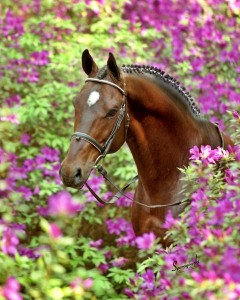 “Polish Arabians don’t have the extreme Arabian characteristics, because they were bred by the Poles to be war horses,” says Freeman. They are stouter and taller than, for instance, Egyptian or English Arabians. Freeman points out that the Poles test every single horse at the track before they allow it to breed. The Poles want horses “that can function, that aren’t just another pretty face.” Polish Arabians usually have more correct canters and trots than other Arabian strains, because their hocks are not as straight.
“Polish Arabians don’t have the extreme Arabian characteristics, because they were bred by the Poles to be war horses,” says Freeman. They are stouter and taller than, for instance, Egyptian or English Arabians. Freeman points out that the Poles test every single horse at the track before they allow it to breed. The Poles want horses “that can function, that aren’t just another pretty face.” Polish Arabians usually have more correct canters and trots than other Arabian strains, because their hocks are not as straight.
Freeman and his trainer showed the Oak Hill Arabians in performance and in hand. They traveled to the big Arabian show in Scottsdale, AZ, mainly for in-hand competition, and they showed extensively in Texas and Louisiana in performance. Freeman’s first show horse was an Arab/Quarter Horse cross which he campaigned in the Half-Arab division hunter classes.
The Oak Hill breeding program, based on the superb Bask line, became a fine source of Polish Arabians. Freeman’s horse Scrabble, a son of Monopolii and grandson of Bask, reached the Grand Prix level in dressage. Samantha Hodgson, who owned and rode Scrabble in his later years, had great praise for the horse: “He was very naturally talented at all the hard movements. The piaffe, passage, pirouettes, and tempi changes were easy for him. Scrabble was always full of fire and ready to go. He had great endurance and stamina. He had a great work ethic and never quit.”
However, the more interested in dressage that Freeman became, the more he thought about breeding a larger horse. Since he was over six feet tall, even the Polish bloodlines were too small. He decided that the thing to do was to cross his Polish Arabian stallions with warmblood mares.
“I had a friend whose wife rode warmbloods, so I called him one day, and it just happened that Leif Sorensen, a dressage master from Denmark, was giving a clinic at his place.” Within a week Freeman was in Denmark with his veterinarian, looking for broodmares. “The purpose of my trip was to get an introduction to warmbloods, but the mares I saw were of such good quality and value that I thought it was worthwhile to get going on that trip.” Freeman chose five Danish Warmblood mares with different attributes, in order to assess which bloodlines would cross best with the Polish Arabian stallions. In time, Freeman sold off most of his purebred stock. In Oak Hill’s crossbred breeding program, Freeman found that the best mix was ¾ Danish Warmblood, ¼ Polish Arabian. Dressage enthusiasts might ask: Why not Hanoverian or Oldenburg or Dutch warmbloods? Freeman says that his choice of Danish Warmblood breeding was pure chance. He had the fortuitous contact with Leif, and he was pleased to find that the Danes were forthcoming with information and help.
Nevertheless, Freeman was a businessman, and he saw that, in dressage circles, Arabians and crossbreds would never equal pure warmbloods in price. With the help of Leif and the advice of the Danish breeding committee, Freeman took on the challenge of raising horses of quality equal to the best found in Denmark. He visited Denmark often, and came to know the top players in the breed, both equine and human. “My best contact in Denmark is Kjeld Kirk Kristiansen, president and major shareholder of Lego,” says Freeman. “He got interested in horse breeding and stallion ownership.”
The finest horse Freeman found in Denmark was Rambo, winner of the 100-day Sporthorse Stallion Test at age three with the highest score ever recorded for a Danish Warmblood. Freeman realized that Rambo was a national treasure, and he made a deal with the Danes to leave Rambo in Denmark. Leif trained Rambo to Grand Prix and they were shortlisted for the Danish Olympic dressage team. Freeman used Rambo’s shipped, frozen semen for the broodmares at Oak Hill. Unless stallion managers follow USDA protocols, importing semen becomes mired in red tape. Both Jan Olsen, Rambo’s former owner, and Kjeld Kirk Kristiansen, who sold semen from several fine stallions to Freeman, had the means and will to qualify semen for importation into the US. The Danish breeding committee helped the Oak Hill breeding program, too: they recommended that Freeman add to his broodmare band by importing fillies under the age of 2 to breed to Rambo. If horses are not of reproductive age, says Freeman, it is a lot easier to go through quarantine.
Freeman imported Rambo from Denmark when the horse was 13 years old, and Rambo stayed with Freeman for 11 more years. Rambo continued breeding and showing until his last year, when he died of arterial heart valve problems. Freeman says, “I rode him in a Prix St. George dressage test when he was 24. The judge made the comment, ‘It’s nice to see the old timers still going.’”
“When I was getting started with the Danes, at first they didn’t even want to register horses in the US.” Freeman convinced them that an American registry was a good idea. Unfortunately, getting the breed organization established proved difficult: a woman with an unregistered stallion wanted to start a registry, too. “We had a lot of controversy at first,” says Freeman, but eventually the North American Danish Warmblood Association was created, and it is an official segment of the Danish Warmblood registry in Denmark. The first approved stallion of the North American division of the Danish registry is Ripline, who is now the top 5-year-old in the country. Bred by Freeman, Ripline’s grandmother, Rambala, is by Rambo, and his sire is Hotline, owned by Kristiansen’s Blue Hors Stud in Denmark.
Freeman likes to celebrate his mares. “I was delighted to see interviews with Ogden Phipps after his horse Orb won the Kentucky Derby,” says Freeman. “The Phipps family has concentrated on mare lines for 100 years. He has seven generations of Orb’s line. Isn’t that wonderful?” Most warmblood breeders name foals using the first letter of the stallion’s name, but Freeman uses the first letter of the mare’s name for both fillies and colts. He began an “R” tradition with Rosetta and Ramona, two of the original mares he found in Denmark, and Roma, imported as a 2-year-old. Rosetta and Ramona were full sisters and were named for their sire, Rossi XX.
The Grand Prix dressage horse Paragon, the alternate for the 2012 Olympic dressage team, is out of Pari Lord, one of the second group of mares which Freeman bought on the advice of the Danish Warmblood Breeding Committee. Heather Blitz, who trained horses at Oak Hill for seven years, bought Paragon from Freeman when the colt was a weanling, and trained him every step of the way to Grand Prix. “I have every expectation that we will see Heather and Paragon at the 2016 Olympics,” says Freeman.
Paragon’s sire is Don Schufro of Blue Hors Stud. Freeman feels fortunate to have discovered Don Schufro, a stellar replacement for Rambo in the Oak Hill breeding program. Don Schufro, an Oldenburg stallion that has been accepted into the Danish studbook, represents the new direction the Danes are taking, under the urging of Kristiansen: the registry is admitting exemplary sires from other warmblood registries. Freeman is disappointed that the Danish registry is losing its Danish purity, but the quality of a horse like Don Schufro is hard to resist.
Freeman attributes much of Oak Hill’s successful breeding program to Dr. Gary Greene. “When I started with Gary, there were only five theriogenologists in the nation,” says Freeman. (That’s a specialist in veterinary reproduction.) “Gary knows how to freeze semen, freeze embryos, transfer embryos—all the high-end reproductive stuff. And he comes to Oak Hill.” Freeman says that, thanks to Gary, Oak Hill has 60-70% positive results with frozen semen and offers a live foal guarantee.
When Freeman and his first wife split, she took the llamas and he kept the ranch and the Polish Arabians. (Around the same time Dick Patterson and his wife also split—and she took the llamas, and he kept the ranch and the Polish Arabians, too.) Freeman has since remarried, and his wife Sarah “loves the whole operation.” She loves going to shows, meeting horse people, and helping to run Oak Hill. Freeman doesn’t show any more, but, he says, he rides for the sake of riding: at present he’s trying to rehabilitate a mount.
Freeman has three children, eight grandchildren, and one great-grandchild. All his children rode in camp, but none is a full-time horseperson. “I had to chase one child away from being an enthusiast of polo,” he says. “A team of four players needs 24 horses just to start a match!” One daughter is a housewife with an artistic sense, one daughter is a retired lawyer and psychiatrist, and a son is interested in computers and photography. The Freeman family oversees two foundations: the largest funding is directed towards public education at the secondary level. “We are trying to take advantage of the renewal of the New Orleans public school system after Katrina,” says Freeman.
Richard and Sarah Freeman attended the Gladstone, NJ, dressage trials for the 2012 Olympics. Of the six highest-placed horses, two were bred in the US. One was the result of Rambo semen which Freeman had sold to the mare owner, and the other was Heather Blitz’s Paragon. Freeman is justifiably proud that Oak Hill has contributed so much to the US dressage elite. He is also proud that, finally, top US riders are looking to their own country for equine talent. Americans used to run to Germany to buy a warmblood. However, buying a horse overseas is not an automatic guarantee of quality. The Europeans have often sent unsuspecting Americans home with horses culled from the national breeding programs. Now, after almost thirty years of warmblood breeding in America, “there’s interest in the press and the US Dressage Federation to get US-bred horses accepted by our top riders,” says Freeman. Here in Louisiana, Oak Hill Ranch is creating stock that is the equal of the best European horseflesh. Look no farther!

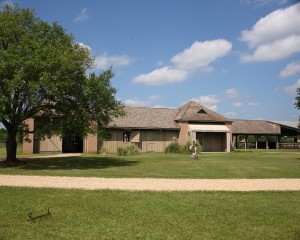

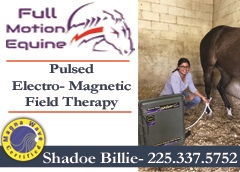
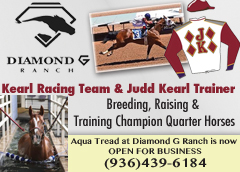
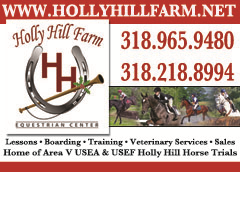

I enjoy this site – its so usefull and helpfull